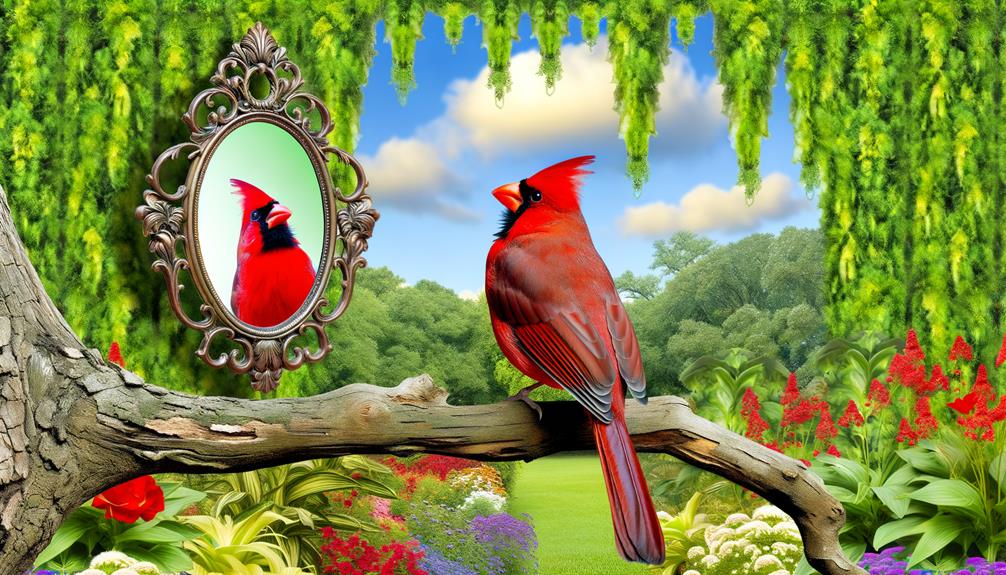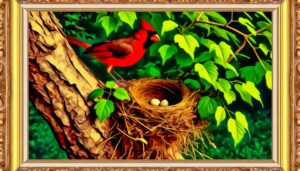Are Cardinals Attracted to Mirrors? A Comprehensive Guide
Cardinals show aggressive behavior when encountering mirrors, misidentifying their reflections as rival birds due to their territorial nature. You’ll notice them pecking, wing-flapping, and singing loudly to defend their space.
These reactions are stronger during the breeding season when their protective instincts peak. Prolonged exposure to mirrors can disrupt their feeding and nesting, causing stress and potentially lowering reproductive success.
Placing mirrors or reflective surfaces thoughtfully to avoid aggressive encounters helps maintain their natural behavior and well-being. Curious about how these interventions can make a difference?

Key Takeaways
- Cardinals mistake their reflections in mirrors for rivals, leading to aggressive territorial behaviors.
- Mirror-induced aggression can disrupt cardinals’ feeding, nesting, and social interactions.
- Elevated testosterone levels during mating seasons heighten cardinals’ aggressive responses to mirrors.
- Preventative measures like decals and blurring reflections can reduce stress and injury risks for cardinals.
- Mirror experiments show cardinals exhibit both attraction and aggression towards their reflections, impacting their behavior.
Cardinals and Mirrors: Reflection Behavior Explained
| Aspect | Details |
|---|---|
| Attraction to Mirrors | Cardinals are often attracted to mirrors and reflective surfaces due to mistaking their reflection for a rival bird. |
| Behavioral Reason | This behavior is most common during breeding season when cardinals become highly territorial and defensive. |
| Frequency of Encounters | Repeated attacks on mirrors or windows can occur multiple times a day as the cardinal tries to fend off the “rival.” |
| Reflection Misinterpretation | Cardinals don’t recognize their reflection, leading them to peck or fly toward mirrors aggressively. |
| Solutions to Prevent Behavior | Cover mirrors or use decals on windows to reduce reflections and prevent stress for the bird. |
Cardinal Reflections
When you observe a cardinal encountering a mirror, you’ll notice the bird often reacts aggressively, mistaking its reflection for a rival. Cardinals are territorial, especially during mating season. They perceive their reflection as another bird encroaching on their space.
You’ll see them flap their wings, peck at the glass, and sometimes even sing loudly. This behavior stems from their instinct to defend their territory from potential threats. It’s fascinating to watch, but it can also be distressing for the bird.
If you want to help, consider covering reflective surfaces with non-reflective materials or installing screens. By doing so, you minimize the stress on the cardinal, aiding them in preserving energy for more essential activities like foraging and nesting.
Understanding Cardinal Behavior
To truly understand cardinal behavior, you need to observe their interactions, feeding habits, and nesting patterns in their natural habitat.
Cardinals are fascinating birds with specific behaviors that can be categorized as follows:
- Interactions: Watch how cardinals communicate with each other using a range of vocalizations and body language. You’ll notice that males often engage in territorial displays to protect their nesting area.
- Feeding Habits: Cardinals primarily eat seeds and fruits. Providing sunflower seeds in your feeder can attract them. Observe that they usually feed in pairs or small groups, and often return to the same spot.
- Nesting Patterns: Female cardinals typically build their nests in dense shrubs or trees. Studying their nesting behavior reveals their preference for secluded, secure locations to protect their young.
Understanding these aspects helps you create a supportive environment for cardinals.
The Science of Bird Reflections
Bird reflections in mirrors provide a fascinating insight into avian behavior. This phenomenon often reveals how birds perceive themselves and respond to what they believe are intruders or potential mates.
When you place a mirror in a bird’s territory, it can elicit a range of behaviors. Some birds may exhibit curiosity, cautiously approaching the mirror and inspecting it from various angles. Others might become agitated, mistaking their reflection for a rival. This reaction can be particularly intense during breeding season when birds are more vigilant.
Territorial Instincts
You’ll notice that cardinals exhibit aggressive reflection responses when they see their own image in a mirror, mistaking it for a rival. This behavior is closely linked to their strong territorial instincts, as they perceive the reflection as an intruder.
Observing their reaction provides insight into their intruder recognition behavior and territorial defense mechanisms.
Aggressive Reflection Responses
When a cardinal spots its reflection in a mirror, it often perceives the image as a rival intruding on its territory, triggering an aggressive response. This behavior stems from the cardinal’s strong territorial instincts.
Observing these reactions can provide valuable insights into their social behavior. They typically:
- Attack the Reflection: The cardinal repeatedly pecks or flies at the mirror, trying to ward off the perceived intruder.
- Exhibit Display Behaviors: You may notice puffing up feathers and vocalizing loudly to assert dominance.
- Increase Vigilance: The bird might patrol the area more frequently, ensuring the ‘intruder’ doesn’t return.
Understanding these behaviors can help you create environments that reduce stress for these vibrant birds, promoting their well-being.
Intruder Recognition Behavior
Building on the cardinal’s aggressive response to its reflection, their ability to recognize and react to intruders is a key aspect of their territorial instincts. You’ll notice cardinals are vigilant defenders of their space, often engaging in confrontational behaviors when an intruder is detected. These instincts are driven by their need to protect resources like food and nesting sites. Observing their behavior, you’ll see distinct patterns:
| Behavior | Description |
|---|---|
| Visual Scanning | Frequent head movements to spot threats |
| Vocal Warnings | Sharp calls to alert and deter intruders |
| Physical Display | Puffing up feathers, spreading wings |
| Direct Attack | Chasing or pecking at the intruder |
Mirror Experiment Results
You’ll find that the mirror experiment revealed several key behaviors in cardinals. They frequently interacted with their reflections, often displaying aggressive postures and vocalizations.
Surprisingly, the data also pointed to some unexpected findings that challenge previous assumptions about their territorial responses.
Behavior Observation Summary
The mirror experiment revealed fascinating insights into cardinal behavior, showing a clear attraction to their reflections.
You’ll find that this attraction manifested in several observable behaviors:
- Prolonged Engagement: Cardinals often spent extended periods examining their reflections, suggesting curiosity or territorial instincts.
- Aggressive Displays: Many cardinals exhibited territorial aggression, pecking at the mirror, which indicates they might perceive their reflection as an intruder.
- Vocalizations: Increased chirping and calling were observed, possibly as a means to communicate with or ward off the perceived rival.
These behaviors underscore the complexity of cardinal interactions with mirrors.
Interaction Frequency Data
In analyzing the interaction frequency data, you’ll find that cardinals engaged with the mirrors an average of 15 times per hour, highlighting their significant interest in these reflective surfaces.
This high frequency indicates a compelling attraction, suggesting that cardinals might perceive their reflections as either potential mates or rivals.
We meticulously recorded each interaction, noting whether the birds exhibited aggressive behavior, such as pecking and wing-flapping, or more curious actions like tilting their heads and chirping softly.
These observations underscore the importance of mirrors in behavioral studies, providing valuable insights into cardinal social dynamics.
Understanding these interactions can help you create environments that either encourage natural behaviors or mitigate stress in settings where cardinals come into frequent contact with reflective surfaces.
Unexpected Findings Analysis
While documenting these interactions, you might come across unexpected findings that challenge initial assumptions about cardinal behavior in the presence of mirrors.
Not all interactions fit neatly into anticipated patterns. Some cardinals exhibited behaviors that were puzzling yet intriguing:
- Avoidance: Instead of engaging, some cardinals actively avoided the mirrors, suggesting a potential fear or discomfort.
- Prolonged Engagement: A few cardinals spent an unusually long time interacting with their reflection, displaying behaviors akin to curiosity or confusion.
- Aggression Variability: The level of aggression varied significantly among individuals, hinting at personality differences or territorial instincts.
These findings underscore the complexity of cardinal behavior and highlight the importance of considering individual variability when interpreting the results.
Understanding these nuances helps you better serve these fascinating birds.
Observations in Nature
Watching cardinals interact with their reflections reveals captivating behaviors that provide insight into their territorial nature. You’ll observe that when a cardinal sees its reflection, it often perceives it as a rival. This misperception leads to aggressive displays, including pecking at the mirror, fluttering its wings, and vocalizing loudly. These actions highlight the bird’s instinct to defend its territory from perceived intruders.
You may notice that both male and female cardinals exhibit these behaviors, though males tend to be more aggressive. Interestingly, the duration and intensity of these interactions can vary, but they’re typically more pronounced during breeding season.
Observing these behaviors in a natural setting helps you understand the cardinal’s instinctual drive to protect its habitat.
Impact on Cardinal Behavior
Understanding these territorial displays helps us examine how mirrors impact cardinal behavior and their daily routines. When cardinals encounter their reflection, they often perceive it as a rival. This can lead to increased stress and aggression, impacting their natural habits. Significantly, you might observe:
- Prolonged Aggression: Cardinals may spend hours attacking their reflection, disrupting their feeding and nesting routines.
- Energy Depletion: The constant territorial defense consumes valuable energy, potentially affecting their overall health.
- Disrupted Social Interactions: Cardinals may neglect interactions with their mates or chicks due to their focus on the perceived intruder.
These behaviors highlight the need for mindful placement of reflective surfaces in cardinal habitats to support their well-being and natural behaviors.
Reflections and Mating Rituals
When you observe cardinals interacting with mirrors, you’ll notice increased aggressive behavior due to mistaken identity.
The birds often perceive their reflection as a rival, which can disrupt their natural mating rituals.
Consequently, this mistaken identity can affect their mating success by misdirecting their energy from courtship to defending territory.
Mirror-induced Aggressive Behavior
Cardinals often exhibit aggressive behavior towards their reflections in mirrors, mistaking them for rival males during the breeding season. This behavior can be quite intense, and you might observe the cardinal repeatedly attacking the mirror. The aggression is primarily driven by the need to protect their territory and attract a mate.
Here are three key points to bear in mind:
- Territorial Defense: Cardinals are highly territorial birds, especially during mating season.
- Hormonal Influence: Elevated testosterone levels during breeding season heighten their aggressive responses.
- Visual Triggers: The bright red coloration of male cardinals increases their likelihood of reacting to reflections.
Mistaken Identity in Reflection
Reflections not only provoke aggression in cardinals but also play a complex role in their mating rituals due to mistaken identity, where they may attempt courtship behaviors towards their own image.
When you observe a cardinal interacting with a mirror, you’ll notice it might display elaborate mating dances, vocalizations, and feather flares. These behaviors, typically intended for potential mates, are mistakenly directed at the reflection.
This misdirected courtship can be quite persistent, as the bird doesn’t recognize the image as itself. Your observations can help understand how these behaviors impact their natural mating processes and provide insights into their cognitive abilities.
Impact on Mating Success
Although interacting with their reflections can be fascinating, this behavior often disrupts cardinals’ natural mating rituals, potentially decreasing their overall reproductive success. When a cardinal mistakes its reflection for a rival, it spends excessive time and energy attacking the mirror, which detracts from important activities like courting and nest-building.
Consider these impacts:
- Reduced Courtship Displays: Time spent on mirror aggression reduces the frequency and quality of courtship displays, important for attracting mates.
- Energy Depletion: Constantly attacking a reflection drains energy reserves, impacting overall health and vigor, vital for successful mating.
- Increased Stress Levels: Mirror-induced stress can lead to hormonal imbalances, affecting reproductive capabilities.
Preventing Mirror Aggression
To lessen mirror aggression, you can strategically place decals or coverings on reflective surfaces to reduce the likelihood of cardinals perceiving their reflections as rivals. By applying opaque or semi-transparent decals, you disrupt the bird’s ability to see a clear image, thereby decreasing aggressive behavior.
Another effective method is to use soap or window film to blur the reflection. Consistently monitoring and adjusting these measures ensures long-lasting effectiveness.
Additionally, placing feeders and birdhouses away from reflective surfaces can help. Observational studies indicate these interventions notably lower stress and injury risks for cardinals.
Enhancing Bird Watching
Observing cardinals in their natural habitat becomes a more rewarding experience when you provide an inviting environment tailored to their needs. Start by focusing on their preferences and behaviors to attract them effectively.
Here are three key elements to take into account:
- Food Source: Provide black oil sunflower seeds, safflower seeds, and crushed peanuts. These are their favorites.
- Water Supply: Install a birdbath with fresh, clean water. Cardinals need water for drinking and bathing.
- Shelter: Plant dense shrubs and trees like dogwood and honeysuckle. These offer protection and nesting sites.
Conclusion
In observing cardinals’ behavior around mirrors, you’ve witnessed nature’s intricate dance. Their territorial instincts drive them to confront their reflections, mistaking them for rivals. It’s like watching a tiny warrior battling an invisible foe.
The data shows that these interactions can impact their stress levels and mating rituals. To prevent mirror aggression, consider covering reflective surfaces. By doing so, you’ll create a more harmonious environment, enhancing your bird-watching experience and supporting our feathered friends.





